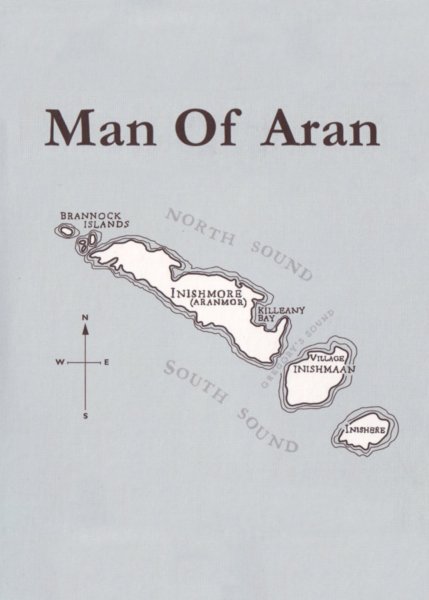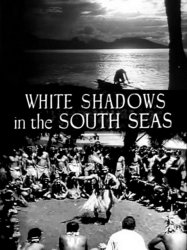Man of Aran is a British film of genre Drama directed by Robert Flaherty released in USA on 18 october 1934
Man of Aran (1934)

If you like this film, let us know!
Released in USA 18 october 1934
Length 1h16
Directed by Robert Flaherty
OriginUnited-kingdom
Themes Seafaring films, Transport films, Films about the labor movement, Documentaire sur le monde du travail
Rating71%










Man of Aran is a 1934 British fictional documentary (ethnofiction) film directed by Robert J. Flaherty about life on the Aran Islands off the western coast of Ireland. It portrays characters living in premodern conditions, documenting their daily routines such as fishing off high cliffs, farming potatoes where there is little soil, and hunting for huge basking sharks to get liver oil for lamps. Some situations are fabricated, such as one scene in which the shark fishermen are almost lost at sea in a sudden gale. Additionally, the family members shown are not actually related, having been chosen from among the islanders for their photogenic qualities.
George Stoney's 1978 documentary How the Myth was Made, which is included in the special features of the DVD, relates that the Aran Islanders had not hunted sharks in this way for over fifty years at the time the film was made. Man of Aran is Flaherty's re-creation of culture on the edges of modern society, even though much of the primitive life depicted had been left behind by the 1930s. It is impressive, however, for its drama, for its spectacular cinematography of landscape and seascape, and for its concise editing.
Synopsis
The film opens with a boy crab fishing. We then observe three fishermen landing a flimsy holed curragh in the force of the wind and the huge waves. Next we see some of the hardships of mundane Aran life: making a field on the barren rocks using seaweed and soil scraped out of rock crevices, fixing holes in the boat with a mixture of cloth and tar, rendering the liver of the giant basking shark. The film follows as the men of Aran harpoon the huge beasts from their bád iomartha (a wooden carvel hulled craft), the film ends with another storm sequence where the distressed family on shore watch the prolonged struggle of the boat to land safely against the elements.Comments
Leave comment :
Suggestions of similar film to Man of Aran
There are 7 films with the same director, 69693 with the same cinematographic genres (including 1041 with exactly the same 2 genres than Man of Aran), 7533 films with the same themes (including 4 films with the same 4 themes than Man of Aran), to have finally 70 suggestions of similar films.If you liked Man of Aran, you will probably like those similar films :

Moana (1926)
, 1h17Directed by Robert Flaherty, Frances Flaherty
Origin USA
Genres Documentary
Themes Seafaring films, Transport films
Rating67%





Tourné sur la petite île polynésienne de Savai'i, le film montre la vie quotidienne d'une famille d'indigènes de l'île, dans le village de Safune.
 , 1h28
, 1h28Directed by Robert Flaherty, W. S. Van Dyke
Origin USA
Genres Drama, Action, Adventure, Romance
Themes Seafaring films, Transport films
Actors Monte Blue, Raquel Torres, Robert Anderson, Dorothy Janis
Rating67%





Dr. Matthew Lloyd, an alcoholic doctor, is disgusted by white people's exploitation of the natives on a Polynesian island. The natives dive for pearls. However, numerous accidents occur and one diver dies. In anger, Dr. Lloyd punches Sebastian, the employer. He tricks Dr. Lloyd onto a ship with a diseased crew (thinking they are ill), and his men rough up Dr. Lloyd and send the ship off into a storm. Dr. Lloyd survives and is washed ashore on an island where none of the natives has ever seen a white man....
 , 1h24
, 1h24Directed by Robert Flaherty, Friedrich Wilhelm Murnau
Origin USA
Genres Drama, Adventure, Romance
Themes Seafaring films, Transport films
Rating73%





Aged emissary Hitu arrives by western sailing ship to the island of Bora Bora, a small island in the South Pacific, on an important mission. He bears a message from the chief of Fanuma to the chief of Bora Bora: a maiden sacred to their gods has died, and Reri has been given the great honour of replacing her because of her royal blood and virtue. From this point on, she is tabu: "man must not touch her or cast upon her the eye of desire" upon penalty of death. This is painful news to Reri and the young man Matahi, who love each other. Matahi cannot bear it. That night, he sneaks her off the ship, and the couple escape the island by outrigger canoe.

Louisiana Story (1948)
, 1h18Directed by Robert Flaherty, Serge Roullet
Origin USA
Genres Drama, Documentary, Adventure
Themes Films about children
Rating64%





A first-hand viewing of the film reveals a story dealing with the adventures of a young Cajun boy and his pet raccoon, who live a somewhat idyllic existence playing in the bayous of Louisiana. A sub-plot involves his elderly father's allowing an oil company to drill for oil in the inlet that runs behind their house.

Nanook of the North (1922)
, 1h18Directed by Robert Flaherty
Origin USA
Genres Drama, Documentary, Adventure
Actors Berry Kroeger
Rating75%





The documentary follows the lives of an Inuk, Nanook, and his family as they travel, search for food, and trade in northern Quebec, Canada. Nanook, his wife, Nyla, and their family are introduced as fearless heroes who endure rigors "no other race" could survive.

The True Cost (2015)
Genres Drama, Documentary
Themes Environmental films, Films about the labor movement, Documentary films about environmental issues, Documentaire sur le monde du travail
Actors Stephen Colbert, John Oliver
Rating76%





Dans The True Cost, Andrew Morgan examine l'industrie du vêtement — en particulier l'économie de la fast fashion — et la relie à la société de consommation, au capitalisme, à la pauvreté structurelle et à l'oppression.

Excellent Cadavers (1999)
Directed by Ricky Tognazzi
Origin USA
Genres Drama, Thriller, Documentary, Action, Historical, Crime
Themes Mafia films, Seafaring films, Transport films, Gangster films
Actors Chazz Palminteri, F. Murray Abraham, Anna Galiena, Lina Sastri, Arnoldo Foà, Ivo Garrani
Rating64%





1992. Le célèbre juge anti-Mafia Giovanni Falcone et son épouse meurent dans un attentat à la bombe alors qu'ils traversent Palerme en voiture. Retour en 1980. Intègre, idéaliste et résolu, Falcone commence sa carrière de magistrat au palais de justice de Palerme. Sa spécialité : les arnaques bancaires...

The Good Hope (1986)
, 1h45Directed by Alex Benno, Guido Pieters
Origin Pays-bas
Genres Drama, Documentary, Romance
Themes Films about animals, Seafaring films, Théâtre, Transport films, Films based on plays
Actors Kitty Courbois, Philip Dorn, Danny de Munk, Renée Soutendijk, Huub Stapel, Rijk de Gooyer
Rating67%






The Long Ships (1964)
, 2h6Directed by Jack Cardiff
Origin United-kingdom
Genres Drama, Documentary, Action, Adventure
Themes Films set in Africa, Seafaring films, Transport films, Films set in the Viking Age
Actors Richard Widmark, Sidney Poitier, Russ Tamblyn, Oskar Homolka, Gordon Jackson, Colin Blakely
Rating60%





The story centres on an immense golden bell named The Mother of Voices, which may or may not exist. Moorish king Aly Mansuh (Sidney Poitier) is convinced that it does. Having collected all the legendary material about it that he can, he plans to mount an expedition to search for it. When the shipwrecked Norseman, Rolfe (Richard Widmark), repeats the story of the bell in the marketplace, and hints that he knows its location, he is seized by Mansuh's men and brought in for questioning. Rolfe insists that he does not know and that the bell is only a myth. He manages to escape before the questioning continues under torture.

In the Wake of the Bounty (1933)
, 1h6Directed by Charles Chauvel
Origin Australie
Genres Drama, Documentary, Action
Themes Seafaring films, Transport films
Actors Errol Flynn, Charles Chauvel, Elsa Chauvel
Rating47%





Chauvel's film uses introductory enacted scenes showing the mutiny, followed by documentary footage, anthropological style, of the mutineers' descendants on Pitcairn Island. Chauvel also used footage of Polynesian women dancers; and film of an underwater shipwreck, filmed with a glass bottomed boat, which he believed was the Bounty but was probably not. This was Chauvel's first 'talkie' and he had clearly at this stage not yet learned to direct actors: the dialogue is very stiff and amateurish. The use of long sections of documentary footage with a voice over, combined with acted scenes, is similar to the hybrid silent and talking pictures that were produced during the transition to sound. It also represents the combination of interests of the director, and he returned to documentary toward the end of his career with the BBC television series Walkabout. Despite the poorly written dialogue, the documentary sections retain their excellence. A return to enactments at the end of the film, with one scripted modern scene in which a child suffers because of the lack of regular ship visits which could have taken the child to hospital, probably sought to make the film a useful voice for the Pitcairn Island community, who had been generous with their participation.
 Connection
Connection